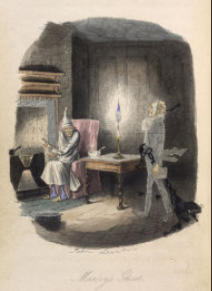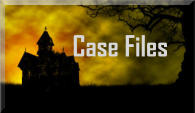GHOSTS: AN HISTORICAL
JOURNEY
PART 2
THE HEADLESS HORSEMAN
Washington Irving was born on April 3, 1783 in New York City and was the
youngest of 11 children born to William and Sarah Irving. The Revolutionary War
had ended and as a tribute, his parents named him after military hero and future
President George Washington and as a six-year-old he attended Washington
inauguration in 1789. Mostly self-taught, he began his eventual career writing
essays under the nom de plume Jonathan Oldstyle for the Morning Chronicle, the
editor of which was his brother, Peter. Irving had decided to become a lawyer and
while not a great student, he nonetheless passed his bar exam in 1806. It was as
a writer, however, that he displayed a true talent. Some early works were critically
well-received but with a stalled career, he entered the military (at one point being
stationed here in Rhode Island at Fort Adams) and fought in the War of 1812.
In 1815, he traveled to England to assist in a family business and while there
wrote a collection of short stories and essays called, The Sketch Book of Geoffrey
Crayon, Gent. The book contained what would go on to become two literary
masterpieces, Rip Van Winkle and The Legend of Sleepy Hollow.
Oddly enough, it was a contagion that brought Irving to Tarrytown, NY as a teenager. Yellow fever
epidemic has struck New York and the environmental conditions upstate would prove much safer and
healthier. He makes veiled reference to this in the story by calling Sleepy Hollow a place with “contagion in
the very air… it breathed forth an atmosphere of dreams and fancies infecting all the land.” He was invited
to stay with his friend, James Kirke Paulding and was immediately taken by the tranquility of his new
surroundings, a stark contrast to the chaotic lifestyle in New York. He found himself attracted to something
else less tangible there: the ghost stories told by the locals. He heard one in particular of a headless
Hessian who was buried near the Old Dutch Church who would ride his spectral steed to the scenes of
conflict to locate his missing head.
The story is actually a combination of two earlier folktales, one Irish and the other German. In the Irish
version, the horseman is actually a horse racer and not evil at all. This is alluded to in the story when
Abraham “Brom Bones” races Ichabod for a bowl of punch. In the German version, an old man who does
not believe in ghosts is taken on the horse as he returns from the hollow and together ride roughshod over
the landscape until they reach a bridge where the horseman morphs into a skeleton, throws the old man in
the river and rides away over the treetops to a roar of thunder.
The idea of the headless horseman has its roots back in Arthurian times, but Irving took it to greater
heights than ever before and many have deemed it, “America’s first ghost”. In it, a mild-mannered,
superstitious Connecticut schoolteacher named Ichabod Crane settles in Tarry Town (now officially called
Sleepy Hollow) at the end of the 18th century. His angular frame, awkward appearance and his bookish
manner make him one of the first literary heroes in a very non-classical way. He immediately is smitten by
young Katrina Van Tassel but there is an obstacle in the form of virile and rebellious Abraham Van Brunt. As
Crane leaves the Van Tassel house after a party one night, he is suddenly chased by the hideous spirit
called the Headless Horseman, supposed to be the ghost of a Hessian soldier who had his head shot off by
a cannonball during the Revolutionary War. In the Horseman’s mind, the battle has never ended. His
identity has always been a catalyst for literary speculation. Was he an actual spirit? A man (perhaps
Abraham) in disguise? Or the Devil incarnate?
Crane rides away trying to escape with the Horseman in hot pursuit, and all that remains of him the
following day are his hat and a shattered pumpkin. Interestingly, perhaps because of the symbolism, this
tale has become a Halloween staple, yet Irving never mentions the holiday, in large part because Halloween
did not exist in any “official” form at the time the tale was written. Another less-discussed aspect of the
story is that in some ways Crane is not as likable as most primary characters are and there are many who
prefer to root for the ghost, an storyline that has found its way into many forms of media since then.
Today the actual town of Sleepy Hollow, NY holds the same grip on people’s imaginations and is said to
be in fact, quite haunted.
THE DOPPLEGANGER
Mary Shelley will forever be immortalized for
her master work, “Frankenstein”. But on July
8, 1822 her husband and a prolific and
accomplished poet in his own right, Percy Byssche
Shelley met his own fate when his ship the Don
Juan went down in a storm off the Gulf of Spezia.
Tragic enough, yes, but the story of Percy Shelley
goes much deeper and it involves a bizarre and
legendary entity called the doppleganger. The
doppleganger translates from German to “double-
goer”. It is a look alike or a double of a living
breathing person. Legend has it that if one sees
their doppleganger, it is a harbinger of disaster. In
his drama, Prometheus Unbound, Shelley
describes the doppelgänger as a counterpart to
the self. As it turns out, he seemed to know that of which he wrote.
Percy and Mary had rented a house in Lerici in April of 1822. Joining them was Mary’s stepsister Claire
and friends Edward and Jane Williams. The house was situated right on the ocean. Shelley was inspired by
the setting and started creating a new poem called The Triumph of Life. Before they arrived at Lerici,
tragedy had already struck their party. Clair’s 5-year-old daughter had died of fever at an Italian convent.
Her father, Lord Byron, had taken her there. Clair was devastated and still trying to work through her grief.
As for Percy Shelley, he was going through a form of trauma himself. One night while standing on the
terrace with Edward Williams, he abruptly pointed to the sea and shouted, “There it is again! There!”
Although Williams saw nothing, Shelley described it as a small naked child staring at him, smiling. At this
time Shelley was having horrible nightmares and these sort of visions while he was fully awake were
becoming more frequent.
This was also a time when the Shelley’s marriage was going through some upheaval. Mary was pregnant
again, having already lost three children and she was quite agitated at the prospect of losing yet another.
Her time at the house was not a happy one and she was prone to dramatic mood swings. She also had a
eerie feeling that something dreadful was about to happen. In June, Mary’s worst fears were realized when
she suffered yet another miscarriage. With no doctor for miles, she was in real danger of bleeding out. But
her husband sat her in a tub of ice to stop the bleeding until it eventually subsided and help could arrive.
A few days later, Shelley claimed to have seen his doppleganger out on the terrace. As they stood face
to face, his double asked, “How long do you mean to be content?” and it was only a week after Mary’s
miscarriage that the entire house was awoken in the middle of the night by Percy’s screams emanating from
his bedroom. He was prattling incoherently about an apparition he had seen of his friend Edward Williams
covered in blood as the ocean flooded the house. This apparition suddenly morphed into another vision,
that of himself strangling his wife while she lay in bed. Was this figure Shelley had seen standing over his
wife the doppleganger who approached him on the terrace? And what was the meaning of his cryptic
inquiry?
It was learned that Shelley had at some point made an attempt to purchase prussic acid and there is
speculation that he did so with the intention of taking his own life with a lethal dose. It is not truly known if
this was his plan, but fate managed to intervene nonetheless. One morning, Jane Williams watched as Percy
Shelley walked past her bedroom window. A few seconds later he walked past again in the same posture
following the same steps as if she was viewing a recording of him. She was puzzled by this, but what she
did not know at that was even more disturbing. Shelley apparently was some distance away on a solitary
walk away from the house making plans to sail his Don Juan toward his eventual doom. He set sail with
Edward Williams down the coast to the town of Livorno. A week later, the men began their journey back to
Lerici, this time accompanied by an 18-year-old deck hand named Charles Vivian. There were some
warnings that bad weather was approaching, but Shelley insisted on setting sail nonetheless.
As nature waits for no one, several hours later the ship was engaged with a terrible storm. Another
boat, seeing their ship struggling mightily in high winds and heavy seas, pulled up to the side of the Don
Juan and offered assistance to them by taking them aboard theirs. Shelly refused. The boat captain advised
them they must take in their sails or risk certain death and Williams made a move to do so. Shelley
grabbed his friend’s arm and sternly exclaimed, “No!”
Ten days later their bodies were found washed up on a beach near Viareggio and in complying with
Italian quarantine regulations, we buried there in the dunes. Shelley’s body could only be identified by the
clothes he wore and the book of poems by Yeats in his pocket. His face and hands had been eaten away by
predators. Eventually his body was exhumed and burned on a pyre at the beach in a pagan-style ritual. His
heart however would not burn and was eventually handed to his wife Mary who kept it wrapped in silk and
safely preserved it in wine inside her writing desk for the rest of her days.
THE GRAY LADY
Captain Frederick Marryat was a British Royal Navy officer and a friend of
novelist Charles Dickens whose work with the supernatural will be discussed
shortly. Marryat was a novelist in his own right, mainly recounting semi-
autobiographical tales of his own life at sea. Not only was he a widely-respected
and heroic warship captain but he was also an innovator of maritime equipment
and devices such as the lifeboat and a now commonly used system of flag
signaling which is famously known as the Marryat's Code. As a novelist, he was
among the very first to write about subjects related to maritime activity. Some
of his fictional work touched on elements of the paranormal such as The
Phantom Ship, which included the ghost ship The Flying Dutchman as a plot
device and contained another short story called The White Wolf of the Hartz
Mountains, the first of its kind to center on the existence of a female werewolf.
While on a hunting party in Raynham, Captain Marryat was to get a closer look at the paranormal not as
a writer of historical fiction, but in a real and physical sense.
During a Christmas gala in 1835, held by Lord Charles Townshend, what would become an iconic ghost
would make its first appearance at Raynham Hall. It was after a game of chess that the men in the party
decided to turn in for the night. Heading to their rooms, they all witnessed the silhouette of a woman in a
brown dress standing in one of the doorways. Without a word and no warning, she vanished into thin air.
The next night a man known only as Colonel Loftus once again saw the same woman, but decided to pay
closer attention to her appearance this time. He described her as having a certain aristocratic manner and a
peaceful behavior but was horrified to notice the woman had no eyes, what he portrayed as a “dark in the
glowing face”.
As the story of the apparition spread, it came to pass that Captain Marryat arrived in Raynham for the
hunting excursion. Not a man easily frightened by ghost stories and a bit of a skeptic in such things actually
existing beyond fictional stories, he was very curious to experience this phenomena for himself if at all
possible. The year was 1836. He posited that this was most likely a trick, perhaps cultivated by smugglers
to keep people away. He asked to be placed in a room where a painting of the woman Col. Loftus claimed
he had seen had been hanging.
Perhaps believing the perpetrator was indeed among the living and not anyone back from the dead,
Captain Marryat slept with a pistol under his pillow in the event whoever this was made an unwelcome
entrance. Two nights passed and nothing out of the ordinary happened. Marryat started to become
convinced the whole thing was as he thought, a plan to scare people away, a hoax, or perhaps just the
overactive imaginations of prior guests. As he was readying for bed the third night, he answered a knock on
his door. Two men were there to ask Marryat’s opinion on a new gun that had arrived from London and
wanted to show him the weapon. After the gun had been thoroughly inspected, they all decided to go back
to Marryat’s room to await the arrival of the ghost together, jokingly suggesting that he take the pistol to
defend himself should she make an appearance.
As they made their way through a darkened corridor to the room they were astonished to see a rather
somber-looking woman coming toward them carrying an oil lamp. Their first reaction was that it was one of
the women in their party so the still half dressed Marryat ducked into one of the bedroom doorways. His
companions did the same. As the woman came closer, Marryat suddenly recognized her as the woman in
the painting in his room. He then gripped the trigger of the pistol a bit tighter and moved to confront her,
but the ghostly woman stopped abruptly in front of them, turned toward them and in his words, “grinned in
a malicious and diabolical manner”. Marryat fired a shot toward the woman who simply vanished. The bullet
lodged in the door across from them and thus ended their brief but eventful encounter with “The Brown
Lady of Raynham”.
Over the next century, stories of Brown Lady sightings in Raynham Hall continued but it was not until
1936 that anyone could provide any documentation of her presence.
On September 19th, a photographer from Country Life magazine
named Captain Hubert Provand arrived with an assistant, Indre Shira
to take pictures of the house for an article being done. The
photographed the staircase when Indre drew attention to something
mist-like coming down the stairs toward them and they both watched
as the mist began to solidify into something that resembles a female.
Shira ordered Provand to aim the camera at the stairs and when he
complied, Shira hit the flash trigger. What they saw upon developing it
astounded them and became one of the most iconic and scrutinized
ghost photos ever taken. The form appeared in the December 26,
1936 issue and it was ran again in the January 4th, 1937 issue.
(Country Life magazine still has possession of the negative from that
day.)
As mentioned, the photo has been analyzed throughout the
decades that followed up until the present day. There are those like
famed paranormal investigator Harry Price who were convinced the
picture was genuine and those that claim double exposure, debris on the camera lens or a living person
coming down the stairs that appears as a blurred figure due to the very long shutter speeds and even
longer development process of camera of that time. One interesting claim is that is the image of the Virgin
Mary superimposed on the stairs. Whatever the case, the photo will remain at least for this time as one of
the most talked about and pointed to examples of photographic paranormal documentation.
Who is the Brown Lady? It is thought by some it is the wandering spirit of
Lady Dorothy Townsend (left), second wife of Lord Townsend. She fell in love
with Charles Townsend and he asked her father for her hand in marriage. Her
father refused. Charles then married a woman named Elizabeth Pelham, but
she died leaving Charles widowed with five children. He and Dorothy
eventually reunited and all seemed well until Charles found out that during
their time apart she had an affair with the father of one of the founders of the
Hell-Fire Club. In a rage, he locked Dorothy in a room and forbade her from
seeing the children. She remained there until smallpox ended her life in 1726.
THE SPIRIT OF CHRISTMAS
Charles Dickens was born in Portsmouth, England in February of 1812 he was born into a very poor
family and had to go to work in a factory at the age of 12 when his father was jailed for an inability to pay
off debt. Young Charles learned quire early in life what it was like to toil in harsh conditions under ruthless
management and this life experience would help with the background for one of the most iconic ghost
stories in all of history, A Christmas Carol. With no formal education, he went on to write 15 novels and
hundreds of short stories. He was also in high demand as a lecturer and, to no surprise given his
upbringing, a staunch advocate of children’s rights and social reform. Other classic works from the mind of
Dickens were Oliver Twist and Great Expectations which follow a theme of many of his novels in painting an
often grim picture of life in Victorian London. A Tale of Two Cities, written in 1859, was set in both London
and Paris but still used a social narrative in its plot. David Copperfield was one of his personal favorites and
it dealt with class struggle, a subject Dickens was very much attuned with. Of all his works, Copperfield is
considered as closest to an autobiography.
Dickens was a great admirer of Washington Irving and was inspired by a Christmas story in Irving’s The
Sketch Book. “I do not go to bed two nights out of seven without taking Washington
Irving under my arm upstairs to bed with me” he once said. In 1843, Dickens began
his story relying on equal parts study into the spirit of mankind and the
supernatural and a mere six weeks later one of the most revered pieces of historical
fiction was completed. The story centers around a miserly business owner named
Ebenezer Scrooge, who only after the pleadings of an employee, Bob Cratchit,
alows him to go home to spend Christmas Eve with his family. By this time he has
already refused an invitation from his nephew Fred to join them for Christmas at
Fred’s home. Now alone and in his misery, Scrooge is visited by four ghosts on
Christmas Eve. First, it is the spirit of his deceased business partner Jacob Marley
who is encumbered with chains, padlocks, keys, ledgers and money boxes he must
carry through all eternity symbolizing the moral constraints of greed and hubris.
Like many ghost stories yet to be written and told, the ghost is also described as
transparent, so that Scrooge could see the buttons on the back of his coat right
through him. He tells Scrooge that he will be visited by three other ghosts and must pay heed to them lest
he suffer the same fate as Marley.
The first is the Ghost of Christmas Past who spirits Scrooge away to the more innocent time of his
boyhood. Scrooge sees himself as a very lonely and isolated child whose closest friend was his sister, Fan.
He then is taken back to a Christmas party that was hosted by his very first employer, Mr. Fizziwig with
whom he had a very close relationship. His transformation into a greedy, insensitive man is revisited with a
vision of his ex-fiancée Belle - who ended the relationship when she came to the realization she could never
be more important to him than money - who is now married and happily celebrating Christmas Eve with her
close and loving family seven years earlier on the very night Marley died. Scrooge is shown how the path he
chose in his formative years robbed him of his own ultimate happiness.
The Ghost of Christmas Present now travels forth with Scrooge to present day England and they bear
witness to people walking about town, gathering all the ingredients for their Christmas dinner, bidding each
other glad tidings. They also visit nephew Fred’s house where all are gathered joyously sharing the holiday
as a family. Fred expresses some concern for his uncle, but they eventually mock Scrooge and quickly turn
their attentions back to the moment and their own happiness. Lastly, they visit the home of Bob Cratchit,
who has a young son they call Tiny Tim an otherwise very cheerful boy, even though he is burdened by a
serious illness. The ghost tells Scrooge the boy will eventually die unless something positive dramatically
changes his fate. Scrooge expresses empathy for the child’s plight, but is rebuked by the ghost for
displaying his concern.
Finally he is visited by the Ghost of Christmas Yet To Come who shows Scrooge
what Christmas will be like in the near future. He is taken to the funeral of a
man who is plainly disliked by even the minuscule amount of people attending.
His is shown no respect and some of his possessions are stolen and sold to a
local fence named Old Joe. Scrooge pleads with the ghost to show him just one
person who mourns a passing and he presents a couple who are in debt to
Scrooge and now rejoice as his death allows them time to put their affairs in
order. Despondent, Scrooge asks to see some sign of compassion for a life lost
and the ghost transports him to the home of Bob Cratchit, where the family is
grieving over the loss of Tiny Tim. In the end, the ghost shows him the man’s
grave, isolated and unkept, bearing the name of Ebenezer Scrooge. Breaking
down, Scrooge pleads with the ghost for another chance to redeem himself.
Scrooge wakes the following morning a changed man thanks to the
intervention of the spirits. He drops in on his nephew Fred and family and sends
along a turkey to the Cratchit household. The next day he greets Cratchit enthusiastically and offers him a
raise in pay. He goes on to befriend Tiny Tim and to treat all with dignity, generosity and respect. In this
story, ghosts are used to turn our eyes back on ourselves, to ponder our own failings as decent and
compassionate human beings and how the lives we lead dictate our own legacies. It is yet another
Dickensian denunciation of the ruling class, but done so playing into all people’s greatest fear, death itself.
A Christmas Carol has gone on to be one of the most adapted and performed stories in all of history on
stage, television and the silver screen.
THE SPIRITUALISTS
In the mid-1800s, a new type of religion rose from what is called, “The Second Great Awakening” a
Protestant religious revival that combined elements of basic human emotion and the supernatural. It took
root in western and central New York around 1840 and was based on the idea that God and angels could be
communicated with. It was in this climate that the writings and ideologies of Swedish philosopher and
theologian Emmanuel Swedenborg and German physician Franz Mesmer flourished as each introduced
methods in which one could create a bridge to the afterlife. Swedenborg claimed he could communicate
with the dead and described what the structure of the afterlife looked like and that the deceased could be
used as a conduit to speak with God. Mesmer introduced a technique that later would be known as
hypnotism, where an individual could be placed into a trance whereupon they could speak to the deceased.
(One of the devices used as a means to communicate with spirits was called “The Talking Board”, which
ultimately came to be more commonly known as “The Ouija Board”. For a more detailed article on the board
go to The Ouija Board Demystified.)
It is commonly believed that the Spiritualist movement began in 1848 in Hydesville, NY with two sisters
from the Fox family named Kate, 12 and Margaret, 15. They claimed to have contacted a spirit they named
“Mr. Splitfoot” (aka The Devil) and could communicate via a series of knocks. Some time later, Mr. Splitfoot
was said to actually be a peddler named Charles Rosna who claimed to have been murdered five years
earlier and buried in the basement. As the communication could be achieved in front of others, they soon
convinced - or perhaps merely recruited - their divorced and poverty-stricken older sister Leah into the fold
and she agreed to manage them. The girls became nothing less than a sensation.
During these heady times, Kate and Margaret relocated to Rochester, NY where Kate lived with her sister
Leah and Margaret stayed with their brother David. Despite the relocations, the rappings continued. A
Quaker couple who were friends of the family, invited them to use their technique in their own home and
became quickly convinced they were the real deal. They spread the word to others in the Quaker
community who soon became among the first devotees of spiritualism. Soon, the girls were performing
before paying audiences in large venues and attracting the attention of celebrities and dignitaries
throughout the world. By 1850, they were demonstrating their abilities in New York City and soon became
media darlings, attracting the attention of P.T. Barnum, James Fenimore Cooper and Horace Greeley who
provided them a place to stay at his mansion.
Soon the girls began performing séances and the audible phenomena soon became visible as well as
objects were moved and tables levitated. It would not be long before others began to claim they too had
the ability to communicate with the other side and séances became a cultural phenomenon. As is usually
the case, the Fox sisters act was also met with extreme skepticism by academics and were put through a
never-ending series of tests including their ankles being bound together and their skirts being checked by a
committee of women to determine whether there was any slight of hand being used. Despite these
examinations, they could not be discredited - as the knocking responses would continue. Grudgingly, these
committees had to admit they could find no wrong doing.
As with all things successful, things run the risk of getting stale and the stakes grow higher. Leah on
more than one occasion was accused of surreptitiously trying to get
information for the audience to make her sisters responses more credible. They
resorted to trying to summon the spirits of the famous like Benjamin Franklin
whose grammar in one session left something to be desired. When one
audience member pointed this out, Maggie stormed off saying, “You know I
never understood grammar!” In spite of, or perhaps because of this lack of pure
artistry, the girls remained wildly popular and profitable.
It was in Philadelphia that Maggie met and fell in love with Arctic explorer
Elisha Kent Kane whose family, despite her fame, did not think Maggie good
enough to marry into their family. Their affair ended tragically in 1857 when
Kane died. All but penniless, Maggie had to return to the stage again after
leaving the business behind in order to marry Kane. It was then that she began
to drink heavily and her overall health and well-being began to deteriorate.
Kate too began a slow descent into alcoholism and her performances suffered
because of it. While performing for spiritualists in England, she met a lawyer there and married, giving birth
to two sons.
In 1885, the spiritualist movement began to decline in numbers and interest and Maggie and Kate’s
ascension to stardom was suddenly on a tragic decline. Increasingly, calls of fraud were sounded and when
Maggie was required to perform a demonstration for an investigative commission in New York, she failed
dramatically. Kate had lost her husband to a stroke and by 1888 she had moved back to New York where
she was arrested for public drunkenness and what was called “idleness”. Her sons were taken from her by
the state. Maggie managed to get them into the custody of a relative in England.
In that same year, Maggie decided to come clean and confess that the act was all a sham. She appeared
at the New York Academy of Music and claimed it was all done by cracking their toes and that Leah had
coerced them into performing as mediums. She also decried spiritualism as nothing more than a sham.
Sitting in a balcony above her sister, Kate nodded in agreement. However, later Kate would say she took
issue with her sister’s account and continued to perform as a medium. Devoted spiritualists passed off
Maggie’s confession as the sad ramblings of a sad, broken and alcoholic woman. By 1891 Maggie would
walk back her statement with some surmising it was all done to spite their sister Leah who made a small
fortune off her sisters, married well and lived the good life exploiting their talents. By 1892, Kate had drank
herself to death at the age of 56 and Maggie passed in 1893 at 59, homeless and destitute.
A POE-LARIZING FIGURE
One of the most influential people in popularizing the Spiritualist Movement was the
famed novelist Edgar Allan Poe. It’s not really known if he truly believed in spiritualism
or perhaps was only satirizing it, but his writings had great effect in its growth either
way. Beyond literature, Poe had interests in cosmology and cryptography along with the
pseudo-science of phrenology, where the shape of a human skull had a direct
correlation to their character. Another influence on his writing was “Mesmerism”,
introduced by Franz Mesmer who claimed that everyone and everything was united by
magnetic forces creating what came to be known as “animal magnetism” and by going
into trances, people could tap into their own bodies to better control them or heal them
or in some cases, following the lead of Emmanuel Swedenborg, contact the afterlife.
The Fox sisters were at their peak of popularity and it was all the rage in Poe’s time, so he naturally
introduced elements of it into his writing.
One of the best examples is the short story, The Facts in the Case of M. Veldemar where a dying man is
put into a hypnotic state at the time of his death so as keep his mind alive after death to see if he could still
communicate after his passing. The story was written from a narrator’s point of view and almost told in a
news story fashion, so people believed it was an actual account of a procedure. For many years, spiritualists
wrote to Poe asking him questions about the final results and of the ultimate demise of the subject until he
grew tired of explaining it was all a made-up story. It was even reprinted in a medical journal in England.
Such was the influence of spiritualism at that point in time.
To illustrate the sway that spiritualism had over a large segment of the populace, we again cite the life
of Poe. A young woman from Providence, R.I. named Sarah Helen Whitman became so infatuated with Poe
she wrote him letters and poems professing her admiration for he and his works. Being a spiritualist herself,
she was enamored with the idea of perhaps becoming involved romantically. She went so far as to write
letters to other female acquaintances of his asking more about him. The first time he saw her was on a walk
past her house with a friend and declined an opportunity to meet her. When they finally agreed to meet
after exchanging poems dedicated to each other, it was only after Poe’s failed suicide attempt via a large
dose of laudanum, a powerful opiate.
Their “get acquainted” walk was through a local cemetery where he impulsively proposed to her among
the headstones. However, she was hesitant to accept because her mother had forbade her to marry him
going so far as to threaten to disown her. It was only after a poetry reading in Providence that she
impulsively agreed, but with one condition: he had to agree to remain sober which proved to be all but
impossible for him. Her mother continued to do her best to interfere with and ultimately terminate their
relationship. Even more so after it was discovered he was courting at least two other women at the time.
Their wedding plans managed to endure these “indiscretions” and would have taken place on December
25, 1848 had it not been for a letter sent to Whitman from a friend confirming that Poe had broken his vow
of sobriety. Staying true to her word, she canceled the wedding. Less than a year later, he was found
delirious on the streets of Baltimore and taken to Washington Medical College where he died four days later.
Details are sketchy about what happened after his death as far as Sarah is concerned, but it is believed
that shortly after his death, Sarah began to hear strange knocking in her room and when she inquired as to
whom the creator of the sounds were, she received responses. She came to believe it was Poe trying to
communicate with her which would follow along with her spiritualist beliefs. It’s also said she hired a
medium to move into her house to assist her with further communication and not long afterwards became a
medium herself and continued her quest to reach out to the spirit of Poe.









































